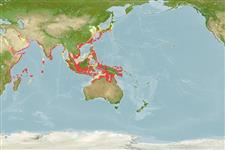Пластиножаберные (акулы и скаты) (sharks and rays) >
Rhinopristiformes (Shovelnose rays) >
Pristidae (Sawfishes)
Etymology: Anoxypristis: Greek, ana = up + Greek, oxy = sharp, pointed + Greek, pristis = saw (Ref. 45335).
Environment: milieu / climate zone / пределы глубины / distribution range
экология
морской; пресноводный; солоноватоводный донно-пелагический; амфидромный (Ref. 51243); пределы глубины 0 - 40 m (Ref. 9859), usually ? - 40 m (Ref. 55270). Tropical; 43°N - 20°S, 30°E - 160°E (Ref. 114953)
Indo-West Pacific: widespread, Red Sea to eastern Australia, north to Japan.
Length at first maturity / Size / Вес / Возраст
половая зрелость: Lm 264.0, range 246 - 282 cm
Max length : 470 cm TL самец/пол неопределен; (Ref. 9859)
Greyish above, pale below; fins usually pale. Body shark-like, pectoral fins distinct; head flattened, with a blade-like snout bearing 18-22 pairs of lateral teeth; blade slender, not tapering distally. Nostrils very narrow with small nasal flaps. Rostral teeth short, flattened, broadly triangular, lacking a groove along posterior margins; no teeth on basal quarter of blade. Adults with widely spaced denticles, young with naked skin.
Body shape (shape guide): elongated.
Found inshore, often in river deltas and estuaries; penetration well up rivers needs confirmation (Ref. 9859). Common in sheltered bays with sandy bottoms. More active swimmer than other sawfishes (Ref. 114953). Feeds on small fish, cuttlefish (Ref. 9859) and small benthic invertebrates such as prawns (Ref. 114953). Ovoviviparous (Ref. 50449). Most fecund sawfish, reported to reach sexual maturity at 2-3 years (Ref. 114953). Females have litters of approximately 12 pups (Ref. 114953). Generally harmless but its saw-like snout may cause serious injury when caught: it is known thrash violently and vigorously (Ref. 9859). Caught for its flesh and liver (which is rich in oil) in some parts of Asia (Ref. 6871). Maximum lengths of up to 610 cm TL are based on unconfirmed reports (Ref. 9859).
Life cycle and mating behavior
половая зрелость | размножение | нерест | икра | Fecundity | личинки
Ovoviviparous. Litter size from 6 to 23, young born in the spring (Ref. 9859).
Mould, B., 1994. A world list of rays. The scientific nomenclature and distribution of the recent Batoidea (Batoidea, Elasmobranchii, Chondrichthyes). University of Nottingham, [UK]. 82 p. (Ref. 8630)
Статус Красного Списка МСОП (Ref. 130435: Version 2025-1)
Использование человеком
рыболовство: коммерческий; объект спортивного рыболовства: да
дополнительная информация
инструменты
Специальные отчеты
Скачать в формате XML
ресурсы в Интернет
Estimates based on models
Preferred temperature (ссылка
123201): 24.6 - 29.1, mean 28.2 °C (based on 1982 cells).
Phylogenetic diversity index (ссылка
82804): PD
50 = 1.0078 [Uniqueness, from 0.5 = low to 2.0 = high].
Bayesian length-weight: a=0.00490 (0.00195 - 0.01230), b=3.05 (2.83 - 3.27), in cm total length, based on LWR estimates for this (Sub)family-body shape (Ref.
93245).
Trophic level (ссылка
69278): 4.5 ±0.62 se; based on food items.
устойчивость к внешним воздействиям (ссылка
120179): низкий, минимальное время удвоения популяции 4.5-14 лет (Fec assumed to be <100).
Fishing Vulnerability (Ref.
59153): Very high vulnerability (90 of 100).
🛈
